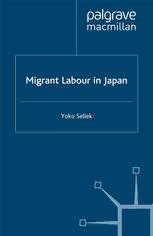
Migrant Labour in Japan PDF
Preview Migrant Labour in Japan
Migrant Labour in Japan This page intentionally left blank Migrant Labour in Japan Yoko Sellek Lecturer School of East Asian Studies University of Sheffield © Yoko Sellek 2001 Softcover reprint of the hardcover 1st edition 2001 978-0-333-80432-2 All rights reserved. No reproduction, copy or transmission of this publication may be made without written permission. No paragraph of this publication may be reproduced, copied or transmitted save with written permission or in accordance with the provisions of the Copyright, Designs and Patents Act 1988, or under the terms of any licence permitting limited copying issued by the Copyright Licensing Agency, 90 Tottenham Court Road, London W1P 0LP. Any person who does any unauthorised act in relation to this publication may be liable to criminal prosecution and civil claims for damages. The author has asserted her right to be identified as the author of this work in accordance with the Copyright, Designs and Patents Act 1988. First published 2001 by PALGRAVE Houndmills, Basingstoke, Hampshire RG21 6XS and 175 Fifth Avenue, New York, N. Y. 10010 Companies and representatives throughout the world PALGRAVE is the new global academic imprint of St. Martin’s Press LLC Scholarly and Reference Division and Palgrave Publishers Ltd (formerly Macmillan Press Ltd). ISBN 978-1-349-42226-5 ISBN 978-0-230-28825-6 (eBook) DOI 10.1057/9780230288256 This book is printed on paper suitable for recycling and made from fully managed and sustained forest sources. A catalogue record for this book is available from the British Library. Library of Congress Cataloging-in-Publication Data Sellek, Yoko, 1956– Migrant labour in Japan / Yoko Sellek. p. cm. Includes bibliographical references and index. ISBN 978-1-349-42226-5 1. Alien labor—Japan. 2. Social integration—Japan. I. Title. HD8728.5 .S45 2000 331.6'2'0952—dc21 00–034488 10 9 8 7 6 5 4 3 2 1 10 09 08 07 06 05 04 03 02 01 For Masanori and Tomoko Sakurai This page intentionally left blank Contents Acknowledgements viii Note on the Text ix Glossary of Abbreviations x Introduction 1 1 Historical Context and Evolution of Foreign Migrant Workers in Contemporary Japan 15 2 Arrival of Foreign Workers through Various Informal Mechanisms 55 3 Foreign Workers in the Context of Economic Recession 93 4 The Increasing Presence of Foreign Residents in Japan in the 1990s 120 5 Infrastructural Problems ± Medical Care for Foreign Residents 140 6 Infrastructural Problems ± Issues Relating to Female Foreign Workers in Japan 157 7 Marriages Between Japanese Nationals and Foreigners 173 8 Infrastructural Problems ± Provision of Education for Foreign Children 197 9 Japanese Society and Foreign Residents ± Anti-immigrant Extremism and Human Rights 208 Conclusion 220 Notes 230 Bibliography 238 Index 256 vii Acknowledgements During my work on this book, I have benefited from the advice and support of many people. It is difficult to single them out but they include Glenn Hook of the University of Sheffield, for reading the whole manuscript and providing many useful suggestions, as well as giving much-needed encouragement. Colin Holmes of the University of Sheffield, Earl Kinmonth of the University of TaishoÅ, Robert Miles of the University of Glasgow, and Marie Conte-Helm of the Daiwa Anglo- Japanese Foundation have read parts of the manuscript and made valu- able comments. Thanks are also due to my colleagues at the School of East Asian Studies, the University of Sheffield who put up with my preoccupation with my task of writing this book. A leave of absence granted by the School in Autumn 1999 greatly facilitated the comple- tion of this book. I am also indebted to the globalization of communication. Without access to the Nikkei Telecom Database provided by the School and the Internet, it would have been impossible to collect much of the informa- tion and useful suggestions from Japanese academia. I am particularly grateful to Takamichi Kajita of Hitotsubashi University for various intel- lectual inputs to this work. Drafts of various parts of the book have benefited from comments at a number of lectures I have given in Britain including at the Daiwa Anglo- Japanese Foundation and the Nissan-Institute in Oxford; these presenta- tions have become the basis of Chapters 4 and 7. Some passages of Chapters 2and 6 have appeared earlier in Japan Forum as `Female foreign migrant workers in Japan: working for the Yen', vol. 8, no. 2, 1996, pp. 159±75, and as `Nikkeijin: the phenomenon of return migration', in Weiner, M. (ed.), Japan's Minorities (London: Routledge, 1997) pp. 178±210; they are used by kind permission of Routledge, Taylor & Francis Ltd., 11 New Fetter Lane, London EC4P 4EE. I wish to also thank my friends, Kenko Hook, Graham Healey, Rick Siddle, Philip Charrier, Alison Churchill and Daniel Frey for keeping my spirits up when flagging, and the nanny of my children, Melanie Sutton, for performing her job with care and love while I was writing. Finally, many thanks to my husband Roger, who managed to remain supportive throughout the entire process, and to my children Akio and Kaya, who did try to be patient but kept my adrenaline pumping. viii Note on the Text The translation of all material from Japanese to English is my own work unless otherwise stated. In transliterating Japanese words, I have adhered to the Hepburn system of Romanization. The transliteration of Japanese words into Roman text presents no problems other than long (double) vowels. A macron is used to indicate the long vowels: aÅ,eÅ, oÅ, and uÅ. ix
